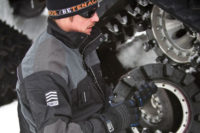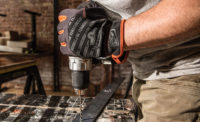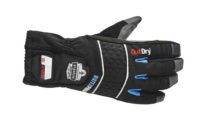Lightweight materials
When we think of “lighter,” the first thing that likely comes to mind is a glove’s weight. Lightweight, technical materials are certainly a trend in today’s hand protection development. These materials have evolved significantly in recent years in everything from lightweight and breathable yet highly durable fabrics used in the construction of traditional cut and sew/trades style gloves, to one-piece seamless knit gloves with dipped palms. Creating lighter weight gloves using advanced materials also serves to improve worker dexterity and hand function, making it easier for workers to accomplish their job safely and effectively.
When it comes to advancements in membrane technology, “lighter” can also be applied to waterproof and thermal/waterproof gloves. Historically, gloves have been made waterproof through the addition of a polyurethane (PU) “insert” that prevents water from coming in contact with the insulation and/or the wearer’s hand. Although the glove is “waterproof,” there is a gap between the outer shell of the glove and the next layer of the waterproof insert. Working in soggy conditions, water (or other liquids) can penetrate the inside of the outer shell of the glove over time, both through the seams and through the saturation of the glove shell fabric itself. This will ultimately lead to an increase in the weight of the glove.
With new bonded membrane technology, a breathable PU waterproof membrane material is adhered (bonded) directly to the inside of the outer shell of the glove, creating one seamless waterproof entity. Unlike a waterproof insert, there is no gap between the glove shell and next layer, making gloves lighter even in the wettest environments. Warmth, comfort, dexterity and durability are also benefits of bonded membrane waterproofing technology.
Improved productivity
“Faster” may seem like an odd word when applied to trends in hand protection, but innovations in glove design have greatly increased workers’ abilities to do their jobs quicker and with increased productivity. Take half-finger gloves; these finger configuration gloves provide protection to the majority of the hand but leave the fingertips free to quickly and easily grab small objects such as nails or fasteners. Designs that offer a combination of full-finger protection on some fingers (typically pinky and ring fingers) and a half finger design on the middle, index and thumb are commonly known as Touch Control or “framer” gloves. This allows workers to maximize protection without compromising dexterity needed to perform the job efficiently.
Advancements in material technology have also allowed gloves to help workers work faster. With more and more tasks involving mobile devices and touch screens, palm materials such as synthetic leather now offer conductivity which allows the operation of these devices without the need to remove a glove. These materials may be used on the entirety of the palm or in specific “zones.” Once sensitive to abrasion and only working with the heat generated by the wearers’ fingertips, these materials have evolved to no longer rely on the wearer to work correctly — the inherent ability to operate touch screens is built directly into the material and they are more durable now than ever before. In addition to allowing workers to quickly and easily accomplish a job-related task, the worker no longer needs to remove their gloves and compromise hand protection; they can keep them on and stay protected on the job.
Stronger protection
The last element, “stronger”, is certainly the easiest to connect to the continued development of protective gloves for workers. The “working” part of any glove is the palm, where great advances in materials have led to stronger, more durable gloves. On cut and sew style gloves, material blends optimized to provide a higher level of abrasion resistance can substantially increase a glove’s life. Technical materials can also be used, either as sewn-on overlays or as middle layers in glove palm construction, to provide increased cut and/or puncture resistance. Technical knit materials may also be used as a sewn-in liner for cut and sew gloves to provide 360-degree (not just palm) protection.
Seamless knit gloves have also advanced in their use of stronger technical materials to provide increased protection against worker hand injuries. These include both branded and non-branded aramids and more recently, high-performance polyethylenes (HPPEs) and other lightweight yet super strong materials providing high levels of cut and slash protection to the entirety of the hand. These seamless knit gloves can then be dipped to coat the palm, or in some cases, the entire glove. Palm coatings such as nitrile provide excellent abrasion resistance and grip. Further enhancements to palm dipping materials such as foaming, where the dipped coating material is injected with air to slightly absorb liquids and then channel them away from the gripping surface, assist in providing workers with a stronger and more secure grip.
The “stronger” element can also be seen in the level of impact protection provided by today’s newer technology work gloves. For impact to the palm region of the hand, technical gels and foams can be integrated into glove designs to absorb shock. Impact protection also applies to the back, or dorsal side, of the workers’ hand, where advances in glove design and technology add elements to the exterior of the glove to provide protection from impact injuries caused by pinches, crushes and bruising blows. This protection comes via the integration of molded rubber armor covering the entirety of the fingers as well as the vulnerable small bones on the back side of the hand. To avoid hand fatigue, this armor should be designed to work with the natural motion of the workers’ hand, not against it, while also providing sufficient protection without compromising flexibility.
Optimal combination of qualities
The ultimate challenge in building gloves for today’s worker is finding the optimal combination of light, fast and strong. The lightest materials may not be durable enough for many tough applications and challenges workers face. The strongest glove may be so “strong” that it affects workers’ hand movements such that they cannot effectively perform the task at hand.
The good news for workers across the globe?
Today’s gloves are lighter, faster and stronger than ever before, and with continued advancement in design and materials, glove innovations are showing no signs of slowing down.



